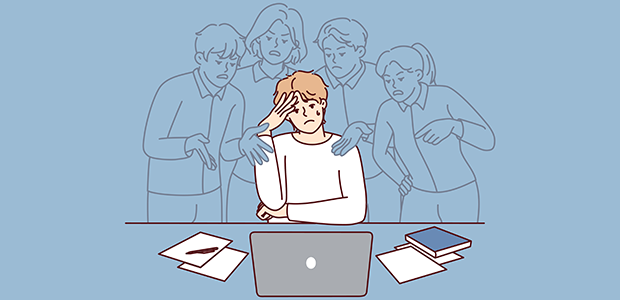
Gen Z and Millennials are feeling the strain: How can employers help?
The economic and social pressures of recent years mean workers are feeling stressed, and those in younger generations are particularly feeling the strain.
Facing a myriad of challenges including dealing with the financial burden of student debt, navigating their way through a challenging housing market, all while struggling with worries about job security, this age group are working longer hours, giving an average of 8 extra hours to work per week. As a result, they are increasingly time poor and have the potential to suffer from burn out.
Mental Health UK’s new report found workers aged 18-24 (34%) and 23% of workers aged 25-34 have had to take time off caused by pressure or stress in the last year. This compares with only 15% of workers aged 55+.
With recent ONS stats suggesting that workplace absences are at a ten year high, with stress being the main cause, it’s important that employers take the wellbeing of their staff seriously if they wish to retain those at the beginning of their careers. After all, these workers will shape the future of their businesses.
So, what can employers do to ensure they are supporting the wellbeing of this new cohort of workers?
The power of communication
Encouragingly, Mental Health UK’s research found that 42% of those aged 18-24 and 25% of those aged 35–44 said their employer had plans in place to help colleagues spot the signs of chronic stress. However, given that a large proportion are struggling, it appears that while younger workers may be aware that their employer offers support, they may not understand its value or how to access it. That’s why having a clear communication strategy is so important.
This can involve hosting regular sessions where benefits on offer are clearly communicated and employees have the opportunity to share alternative options that would better support them. In forums such as these, leaders can also share their own experience of stress and mental health and how they were able to manage their symptoms. This can “give permission” to younger employees to do the same and support people to speak openly with colleagues or line managers.
Training managers to spot the signs
It’s essential that managers have the right training to spot the signs of stress and burn out and have a plan for how to manage the situation when they do.
Signs of burn out in employees include working longer hours, making mistakes, not participating in team activities, whether that’s in work or in social hours, or displaying a negative attitude to tasks.
A robust wellbeing strategy to help tackle these issues when they arise is key. This includes asking employees questions about their workload and encouraging them to take time away from work through pursuing hobbies or taking annual leave.
It’s important that managers foster a culture of collaboration, with activities such as team building sessions being prioritised to help alleviate feelings of stress or loneliness.
If a team works fully remotely, it’s important to prioritise regular opportunities to connect. With a Deloitte survey finding 14% of Gen Z and Millennials feel working remotely makes connecting with colleagues difficult, it’s vital managers prioritise organising regular virtual check ins or team away days.
Why individualised support is key
According to analysis from Gartner, recent events such as the pandemic have forced people to “examine their choices about how they spend their time, energy and social capital.” Now more than ever, those earlier on in their career are looking for more from their workplaces and how they can meet both their personal and professional needs.
One approach employers can take is the model through which they deliver private medical provision. At Healix, we advocate a Healthcare Trust and believe this gives businesses more choice and flexibility over what provision they offer and to whom.
Through this, employers can really listen to and look at their workforce’s needs before offering wellbeing solutions that cater for their individual circumstances. Provision can include neurodiversity and mental health benefits, or support for the LGBTQ+ community.
Taking a digital-first approach
Employers must meet young people where they are by making mental health and wellbeing support more accessible through online tools.
Mental health platforms can be accessed 24/7, with conversational AI being used to surface relevant and personalised wellbeing support. This can help to stop negative thoughts and behaviours in their tracks through providing instant, tailored advice.
With NHS waiting lists soaring, it’s becoming increasingly difficult for people to see a GP quickly, with the knock-on effect being increased stress and worry. Employers can respond to this through providing a Virtual GP service, allowing employees to access primary care within 24 hours and attend appointments from their home.
Addressing stress to future proof a business
A further study by Deloitte has found that a proactive approach to wellbeing is proven to bring better outcomes and contribute to a happier workforce. It also leads to greater ROI for employers, with Deloitte’s financial analysis finding that wellbeing measures by employers will yield a return on average of £5 for every £1 spent through boosted productivity.
It’s not enough just to bring in wellbeing interventions as a tokenistic gesture without a well thought out strategy alongside. Employers that take a planned approach will be the ones that come out on top.

